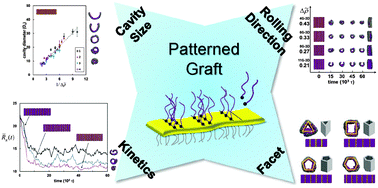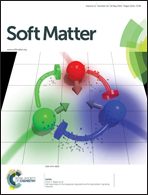Self-rolled nanotubes with controlled hollow interiors by patterned grafts
Abstract
By patterning surface grafts, we propose a simple and systematic method to form tubular structures for which two-dimensional grafted sheets are programmed to self-roll into hollow tubes with a desired size of the internal cavity. The repeating pattern of grafts utilizing defect sites causes anisotropy in the surface-grafted nanosheet, which spontaneously transforms into a curved secondary architecture and, thus, becomes a potential tool with which to form and control the curvature of nanotubes. In fact, the degree and the type of graft defect allow control of the internal cavity size and shape of the resulting nanotubes. By performing dissipative particle dynamics simulations on coarse-grained sheets, we found that the inner cavity size is inversely proportional to the graft-defect density, the difference in the graft densities between the two surface sides of the layer, regardless of whether the defects are patterned or random. While a random distribution of defects gives rise to a non-uniform local curvature and often leads to twisted tubes, regular patterns of graft defects ensure uniform local curvature throughout the sheet, which is important to generate monodisperse nanotubes. At a low graft-defect density, the sheet-to-tube transformation is governed by the layer anisotropy, which induces spontaneous scrolling along the long edge of the sheet, resulting in short tubes. Thus, the curve formation rate and the cavity diameter are independent of the pattern of the graft defects. At a high graft-defect density, however, the scroll direction owing to the graft pattern may conflict with that due to the layer anisotropy. To produce monodisperse nanotubes, two factors are important: (1) a graft-defect pattern parallel to the short edge of the layer, and (2) a graft-defect area wider than half of the graft coil length.


 Please wait while we load your content...
Please wait while we load your content...